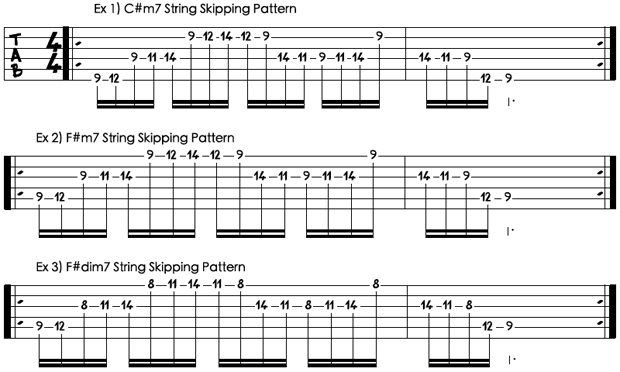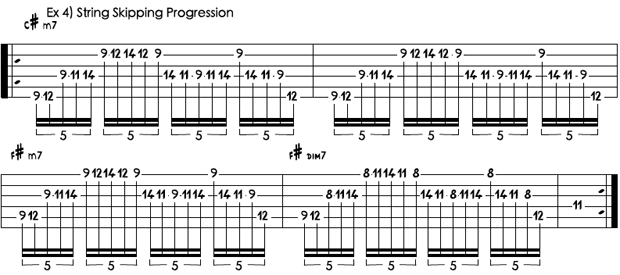Improve your shredding skills by connecting string-skipping patterns
These patterns are easy to link up with your pentatonic scales, and can be very useful for adding some flash into your riffs and solos

In this lesson, I’m going to demonstrate some basic string-skipping patterns. These patterns are easy to link up with your pentatonic scales, and I think you’ll find them very useful for adding some flash into your riffs and solos.
I’m going to play them separately at first, and then at the end of the lesson, I’ll string them all together into a chord progression.
First let’s take a look at EXAMPLE 1. This is a C#m7 arpeggio in the 9th position starting with the root note on the low E string. Notice that this pattern is in the same position as your typical C# minor pentatonic scale. I tend to play string skipping arpeggios with hammer-ons and pull offs - only picking when I change strings or change direction.
Try to learn all of the patterns with this method before you attempt alternate picking every note. You’ll find they’re initially easier to work up to speed.
For EXAMPLE 2, I’m going to take the shape from EXAMPLE 1 and move it up a string so that the root of the arpeggio is on the ninth fret on the A string. This changes the chord to an F#m7 arpeggio. Be sure to use the same picking and fingering patterns as the first example, this will help you work up speed and keep your technique consistent.

NOTE: All 7th chord string-skipping patterns that have the root note on the low E string can be moved to the A string to get another arpeggio a 4th higher. Moving on to EXAMPLE 3, we’re going to stay in the 9th position and play an F#dim7 arpeggio with the root on the A string. This is another common string skipping pattern that I like because the fingering on the G and E strings is exactly the same. Once again, be sure to keep your picking consistent with EXAMPLES 1 and 2.
NOTE: Once you have EXAMPLE 3 down in the 9th position, try sliding it up three frets to the 12th position. This is the same arpeggio but in the first inversion. You can do this with all diminished string skipping patterns. This pattern can also be moved to the E string for different diminished arpeggios.
Finally, for EXAMPLE 4, I’m going to combine EXAMPLES 1, 2, and 3 into a progression in C# minor. The progression is C#m7 – F#m7 – F#dim7. Focus on making the transitions between the arpeggios seamless.

Once you have these patterns down, try throwing them into your leads. They’re in the same position as the C# minor and C# minor pentatonic scale, so they’re easy to find all over the neck in many different keys. Cheers!
Sammy Boller is the guitarist for the Detroit rock band Citizen Zero. They’re touring and recording their first full-length album with Al Sutton and Marlon Young (Kid Rock, Bob Seger, Uncle Kracker). In 2012, Boller was selected by Joe Satriani as a winner of Guitar Center’s Master Satriani competition. He studied music at the University of Michigan. For more about Boller, or to ask him a question, write to him at info@sammyboller.com or follow him on Twitter.
Get The Pick Newsletter
All the latest guitar news, interviews, lessons, reviews, deals and more, direct to your inbox!







![Joe Bonamassa [left] wears a deep blue suit and polka-dotted shirt and plays his green refin Strat; the late Irish blues legend Rory Gallagher [right] screams and inflicts some punishment on his heavily worn number one Stratocaster.](https://cdn.mos.cms.futurecdn.net/cw28h7UBcTVfTLs7p7eiLe.jpg)


